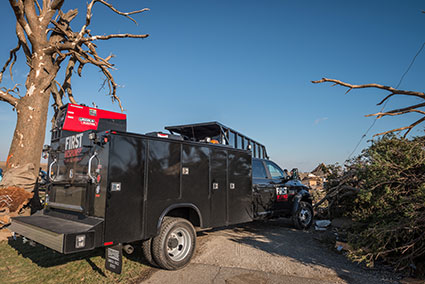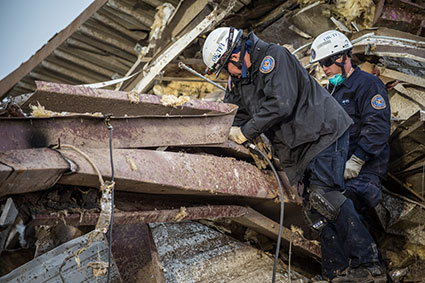FIRST RESPONSE TEAM OF AMERICA
Help in a Hurry When Disaster Strikes
Fueled by passion and donations, First Response is on the scene in the critical early hours after catastrophes, deploying the tools and equipment needed for recovery
Skies boiled above central Oklahoma on May 20, 2013. Through the previous weekend, a massive weather system’s black brew dropped several tornadoes onto the Great Plains, but saved its terrifyingly worst for the Oklahoma City suburb of Moore on that Monday afternoon. Growing to more than a mile wide and packing winds in excess of 200 mph, a monster twister laid waste for 39 minutes along a 17-mile track, its path intersecting Moore’s most heavily populated neighborhood.
Just east of the city, a one-of-a-kind group had prepositioned. As the tornado departed Moore, First Response Team of America entered. Under escort, the team’s semis and trailers, loaded with heavy equipment and disaster-cleanup tools, snaked their way through the rubble that had once been a subdivision to Plaza Towers Elementary School. First Response deployed its specialized equipment and partnered with firefighters and other rescue personnel to dig through and search for victims amid twisted steel girders and piles of bricks. That day, 24 people died in Moore with 377 more injured. Seven children perished at Plaza Towers. Rescue and recovery work continued around the clock at the school and throughout the city of 55,000, where estimates count more than 1,100 homes destroyed and $2 billion in damage. First Response would stay on in Moore for nearly three months, focusing on homesite-clearing for those without insurance after the initial search-and-rescue phase, then head to Colorado to assist in recovery from devastating floods.
Donations, Commitment Bring Hope for Disaster Victims
From its base in Lancaster, Pa., First Response Team of America travels the country, bringing early-response disaster rescue and recovery services where needed. The nonprofit organization, with five on-disaster-site primary personnel backed by heavy-equipment operators, office staff and volunteers, has a straightforward mission: respond to communities in need in the initial hours after a natural disaster. It has done just that in more than 60 communities since its first mission eight years ago. The team carries specialized equipment including cranes and skid loaders for clearing roads, hovercrafts for water rescues, generators for powering emergency facilities, water pumps for floods, and communication devices to reconnect victims with loved ones.
“We go into a situation where every single thing has gone wrong,” explains Tad Agoglia, founder of First Response. “In these situations, people look for anything to be hopeful about. When we start clearing a road and cutting metal that clogs the way, the community sees that. They see progress and think, ‘maybe this isn’t the end, maybe we can clean up this place.’ We can’t solve all the problems caused by a storm, but we can make a contribution.”
Throughout the United States, and even over the ocean to Haiti in the wake of the 2010 earthquake, First Response has contributed to recovery efforts after all manner of natural disasters, including hurricanes such as Isaac and Sandy, and Tropical Storm Debby in 2012. It also has aided recovery after tornadoes in Elmira, N.Y., West Liberty, Ky., and Joplin, Mo.
Heading into a storm zone, First Response first identifies who is in charge – it may be a mayor, emergency-response official or fire chief – and then offers its help.
“We are welcomed in the community due to the resources we have packaged to help disaster victims,” Agoglia says. “Early on, clearing roads is very important, allowing ambulances and fire trucks to get through. Often times we are involved in search and rescue, where we use plasma cutters, light towers and loaders. Then we begin powering shelters and clearing debris. We may even get called to dig through homesites to find pets that might still be alive.”
Soul Searching takes Disaster-Recovery Business in New Direction
The evolution of First Response dates to the restlessness of its founder. A searching soul, Agoglia began looking for more meaning in life throughout his 20s, he recalls. The death of his father during this period intensified that search.
“My father passing away reminded me that life is short,” says Agoglia, “and I wanted to make each day count for something.”
Agoglia had grown his for-profit disaster-recovery business into a successful multi-million-dollar operation, where he and his crew would arrive weeks or months after catastrophes. Not fully satisfied, Agoglia started to wonder what went on during the most stressful minutes and days following a disaster.
“Instead of coming in two or three months later to clean up debris, I wanted to come in on day one to help,” he says. “I had never been to a disaster within a few hours. When these large-scale disasters strike, who is there to help these folks? They turn to fire departments or small-town municipal public works departments. Neither of these has the equipment needed to clear debris on a large scale. What do these communities do in the first few weeks before additional help arrives?”
Thought turned to action on the evening of May 4, 2007, when an EF-5 tornado – the most intense and destructive classification, packing wind speeds greater than 200 mph and capable of causing catastrophic damage – tore through tiny Greensburg, Kan. The twister leveled an estimated 95 percent of the town and killed 11.
“I decided to go there to see if they need help,” Agoglia recalls, “and that is how First Response was born.”
With a small crew and his tractor trailer filled with equipment, Agoglia raced to Greensburg.
Arriving in the middle of the night, Agoglia met a firefighter manning a roadblock. Detailing the equipment in the truck, Agoglia asked what he could do.
“Can you help us clear a road to the firehouse where our fire trucks are?”
“Absolutely,” Agoglia replied.
By sunrise, Agoglia could see the firehouse nearby, and the roads covered in debris.
“At that moment,” he says, “I decided that this is what I want to do for the rest of my life. I want to help people affected by disasters and don’t want to charge them, because these people are at their lowest points. Everything they’ve worked for in their whole lives, in a manner of seconds, it is all gone.”
Special, Durable Equipment Needed
Upon this revelation, Agoglia took his employees and equipment into harm’s way for the next two years, spending more than $1 million of his own money in the process. He also learned a lot.
“On my first day in Greensburg, I realized that I didn’t just need a crane and a wheel loader, I needed a plasma cutter to cut through all the steel girders and I-beams entangled in the debris in order to reach the firehouse,” he says. “In responding to subsequent disasters, we learned that other equipment was needed. We needed a big commercial generator to power hospitals, nursing homes and shelters. We needed a light tower because no other electricity and lighting was available. We needed a hovercraft because fire departments don’t have the proper boats for rescuing flood victims. We needed water pumps to empty out critical buildings that need to get back up and running. I went out and bought all this stuff.”
As First Response continued its work, companies approached, wanting to help. Caterpillar offered heavy construction equipment and huge generators, as well as local access to equipment from distributors. The Pete Store, a Peterbilt distributor based in Baltimore, Md., offered heavy trucks. A Texas company, Ledwell, provided large trailers. Chrysler provided Dodge Ram pickups. Bosch provided tools and other companies continued to step up, donating myriad equipment, supplies and services.
Through its association with Caterpillar, Lincoln Electric made contact with First Response and joined the effort. The Cleveland, Ohio, company supplied two Ranger® 305 G engine-driven welder/generators and two Tomahawk® 1000 plasma cutters, as well as welding gear in 2012, and a Ranger® 305 D engine-driven welder, another Tomahawk 1000 and additional welding gear in 2013.

“Tad was looking to use the equipment in a variety of ways,” explains Matt Fleming, manager of construction and rental sales for Lincoln Electric. “First Response does perform small amount of welding onsite, but primarily uses the engine-driven welders’ 10,000 watts of auxiliary power to run tools and lights, and charge batteries. The plasma cutters powered by those generators are used for demolition – cutting steel or consolidating metal to clean a site or enable access.”
First Response uses the welders to repair its own equipment, a vitally important function as the team and its gear must be ready to go 24/7, and serve ably in the field.
Agoglia is more than appreciative of the equipment he receives from all of his donors, noting that dependability is paramount in disaster situations, and that his roster of equipment has delivered time and again.
“Lives depend on the work we do,” he says. “On a contracting job, a downed welder or plasma cutter means loss of profit, but doing the work that we do, it could mean loss of life.”
Touring the factories where donated equipment is built, Agoglia notes the pride of workers and the commitment to the First Response cause from management. This pride and commitment manifests itself at the scene of disasters, where equipment continues to perform in incredibly hostile environments.
“Now we have a group of supporters,” says Agoglia, describing First Response’s funding, “including the corporate donors, business people and individuals that may send $5 via our website, firstresponseteam.org. In 2013, we were on the road 10 months, which means a lot of money for food, lodging, maintenance and other expenses. It costs $10,000 in fuel just to get somewhere. So we truly appreciate donations in all forms.”
At its homebase in Lancaster, First Response and its equipment occupies a large building donated by a local company, High Real Estate.
“During downtime, our people perform repairs, replenish inventory and more,” Agoglia says. “We also undergo training in equipment use and emergency rescue. We are always busy – there’s never a day off.”
Weather Channel Partnership Brings Greater Opportunities to Help
In 2012, The Weather Channel and Ram Trucks partnered to bring the efforts of First Response to the television network, as well as weather.com and mobile and tablet platforms. As part of the package, Ram donated trucks for use by the First Response team. The Weather Channel stories highlight the team in action as it undertakes recovery missions.
“The Weather Channel and First Response Team of America have a mutual passion for helping people prepare for and recover from dangerous weather,” says Stu Ostro, senior meteorologist at The Weather Channel. “TWC and I are being constantly vigilant and providing updates to Tad as such situations develop.”
Close contact ensures that Agoglia and First Response are always in the loop.
“I include Tad on my email distribution list so that he gets my tornado probability (TOR:CON) forecasts, sometimes predicting high tornado probabilities out to even a week in advance,” explains Dr. Greg Forbes, The Weather Channel’s severe-weather expert. “We follow that up with individual consultations that help Tad to pre-deploy to areas when and where dangerous tornadoes are likely. In this way, his team can sometimes travel 500-1000 miles or more ahead of time and be nearby to help out where a major tornado strikes.”
From there, First Response’s experience and drive kick in, backed by solid equipment and the generosity of donors. The payoff: victims know that help is here.




